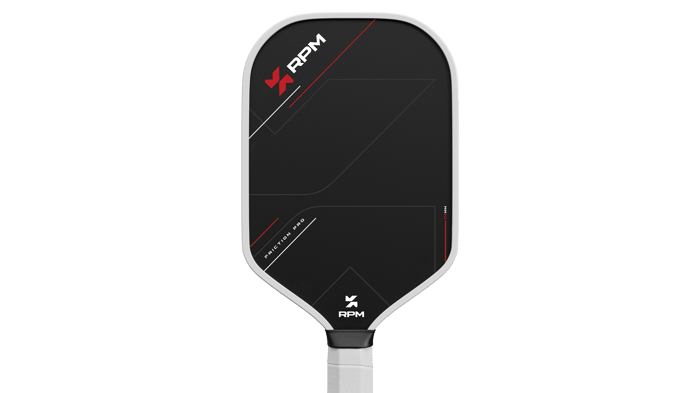Understanding pickleball paddle construction is the first step toward choosing a paddle that elevates your game. These performance tools are built from three principal components—the face, the core, and the handle—plus one optional but important feature: the edge guard. The interaction of these elements defines everything from spin potential to vibration dampening.
1. The Paddle Face: Your First Point of Contact
This is the striking surface - the interface between paddle and ball, where energy transfer, spin generation, and touch control converge. The composition of the face plays a defining role in whether a paddle feels lively or plush, reactive or absorbent. RPM engineers obsess over face sheet behavior under high-speed impact and dwell time modulation.
There are a wide range of materials that are used on pickleball paddle face sheets.
Carbon Fiber: The gold standard for control and face stability. Featherlight yet ultra-durable, this surface provides excellent feedback and spin.
Fiberglass: A bit more forgiving, fiberglass blends flex and force — ideal for players wanting added rebound.
Kevlar: Kevlar brings a muted, plush feel with anti-vibration characteristics.
Graphite: Thin, stiff, and highly responsive - less common in advanced paddles.
2. The Core: The Heart of the Paddle
Nestled between the face sheets, the core is what gives a paddle its backbone — quite literally. RPM cores dictate shock absorption, power potential, and acoustic signature. A well-designed core balances structure with sensation.
Common core materials in RPM paddles:
Polypropylene: Consistent, versatile, and works best when paired with an EVA Foam ring around a portion of it - ideal for players of all skill levels.
Foam Variants (EVA, EPP, EPS): These create a pillow-like feel with minimized vibration. Most foam variants are still in the experimental stage - the “full foam” paddle is yet to be mastered, as many full foam variants are deemed illegal (too powerful for USAP/UPA standards)
Nomex: A hard, fast-reacting aramid paper core for those seeking extra pop. Great for aggressive players. Often lacks the control necessary for high level play.
Aluminum: Lightweight, but not built for power hitters. Not recommended for advanced play.
Core Thickness Matters
13-14mm Range: Leaner cores = faster rebounds, more power, less “dwell time” and control.
16mm Range: Thicker builds = slower exit speeds, more control, longer “dwell time.”
RPM currently engineers both to suit player preference.
3. The Handle: Where Player Meets Paddle
Often overlooked, the handle is your connection to the paddle — and by extension, to the game itself. RPM handle design considers torque management, grip fatigue, and multi-shot adaptability.
Key Handle Considerations:
Grip Circumference: Usually between 4” and 4.5”. Too small and you’re overgripping (hello tennis elbow); too big and wrist mechanics suffer.
Handle Length:
Extended: For two-handed backhands and added leverage.
Compact: For quicker hand switching and net maneuverability.
4. Edge Guard (or Not): The Unsung Hero
Encasing the paddle perimeter, edge guards serve as body armor — absorbing impact, shielding layers, and preventing delamination over time. RPM edge guards are sleek, minimal, and performance-friendly.
Final Thoughts: Why It Matters
At RPM, we don’t just build paddles — we build performance tools. Every fiber, every resin layer, every gram of core foam is selected with intentionality.
Whether you’re grinding out soft dinks or hunting passing shots, your paddle’s construction will either elevate your ceiling or limit your game. Understanding the materials — and how they work together — helps you make smarter decisions, whether you're a beginner or looking to dominate your next tournament.
Take the time. Ask questions. Demo broadly. Because when you find the right build, it won’t just feel better — it will make you better.
Frequently Asked Questions (FAQs)
Q1. What are the main components of a pickleball paddle?
The three principal components are the face (the striking surface), the core (the internal structure that provides power and dampening), and the handle (your connection to the paddle). An optional but important fourth feature is the edge guard, which protects the perimeter.
Q2. How does the paddle face material (carbon fiber vs. fiberglass) affect my game?
The face material dictates spin potential and feel:
Carbon Fiber is often considered the gold standard for control and spin. It's stable, durable, and provides excellent feedback.
Fiberglass (or composite) is more forgiving, blending flex and force for a slightly added rebound (more pop) compared to carbon fiber.
Q3. What is the difference between a thin core (13mm-14mm) and a thick core (16mm)?
Core thickness is a major factor in paddle performance:
Thin Cores (13mm-14mm): Result in faster rebounds and more power due to less material to absorb the ball's energy. They offer less "dwell time" and control.
Thick Cores (16mm+): Offer slower exit speeds and more control. The added material absorbs more energy, resulting in a softer feel, longer "dwell time," and better shock absorption.
Q4. Which core material provides the most power: Polypropylene, Nomex, or Aluminum?
Nomex cores are typically the hardest and fastest-reacting, offering the most sheer pop or power, ideal for aggressive players. Polypropylene (Polymer) is the most common and versatile, offering a balanced mix of power and control. Aluminum cores are lightweight but generally not built for power hitters.
Q5. Why is the handle grip circumference important?
Grip circumference (usually 4" to 4.5") is crucial for preventing injury and optimizing technique. A grip that's too smallcan lead to over-gripping (causing wrist fatigue or tennis elbow), while a grip that's too big can hinder wrist mechanicsrequired for spin and quick maneuvers at the net.

